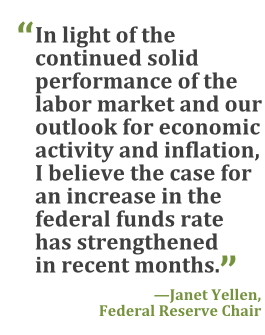Federal Reserve Chair Janet Yellen said the case to raiseinterest rates is getting stronger as the U.S. economy approachesthe central bank's goals.
|“In light of the continued solid performance of the labor marketand our outlook for economic activity and inflation, I believe thecase for an increase in the federal funds rate has strengthened inrecent months,” she said in a speech Friday to central bankers andeconomists in Jackson Hole, Wyoming.
| Yellen also said the economy is “nearing” the Fed's goalsof full employment and stable prices. The Fed chair didn't discussthe specific timing of a rate move in her first public commentssince June.
Yellen also said the economy is “nearing” the Fed's goalsof full employment and stable prices. The Fed chair didn't discussthe specific timing of a rate move in her first public commentssince June.
“September is certainly on the table, a possibility, and beingconsidered,” said Laura Rosner, senior U.S. economist at BNPParibas in New York. “She strongly is keeping that in place. Ithink she's putting the emphasis on the data and how the labormarket performs, and that's really what we should bewatching.”
|The Federal Open Market Committee (FOMC) raised its target forthe federal funds rate to a range of 0.25 percent to 0.5 percent inDecember, after keeping the benchmark near zero for seven years.The FOMC's next meeting is on Sept. 20-21.
Delayed Interest Rate Hikes
Despite their repeated intentions to raise the rate again,officials have skipped a hike at all five meetings this year, andfutures markets have priced in about a 30 percent chance of anotherincrease next month, the second-to-last gathering beforepresidential elections in November.
|“While economic growth has not been rapid, it has beensufficient to generate further improvement in the labor market,”Yellen said at the Kansas City Fed's annual conference, the titleof which is “Designing Resilient Monetary Policy Frameworks for theFuture.”
|“Looking ahead, the FOMC expects moderate growth in real grossdomestic product, additional strengthening in the labor market, andinflation rising to 2 percent over the next few years,” Yellensaid. “Based on this economic outlook, the FOMC continues toanticipate that gradual increases in the federal funds rate will beappropriate over time to achieve and sustain employment andinflation near our statutory objectives.”
A Commerce Department report released earlier Friday showed theU.S. economy grew less than previously reported last quarter onlower government outlays and a bigger depletion of inventories,capping a sluggish first-half performance propped up mainly byconsumer spending. Gross domestic product, the value of all goodsand services produced, rose at a 1.1 percent annualized rate, downfrom an initial estimate of 1.2 percent, the report showed.
|“If there was some doubt about whether or not rates will come upthis year, there are fewer doubts today,” said Roberto Perli, apartner at Cornerstone Macro LLC in Washington. “September?Let's see how the employment data come in. If it's another strongone, a lot of people on the FOMC will have a strong case tomove.”
|The U.S. Labor Department releases the August payroll report onSept. 2. Analysts surveyed by Bloomberg expect employers added185,000 jobs last month after adding 255,000 in July, and theypredict the unemployment rate nudging down to 4.8 percent.
|The Fed chair's speech comes amid a reassessment among centralbanks globally about future strategies for monetary policies, atopic she addressed in the second half of her remarks. Agingpopulations, declining productivity, and below-target inflationrates are likely to result in lower peaks in their policy interestrates. That means central banks are likely to reach the zeroboundary on their policy rates faster in the next recession.
|San Francisco Fed President John Williams, Yellen's formerresearch director when she was head of that bank, urged centralbanks in an essay earlier this month to “carefully reexamine” theirstrategies, and mentioned the possibility of raising inflationtargets, among other options.
Enough Ammo
By contrast, David Reifschneider, a special adviser to Fedgovernors, argued in a paper that “even in the event of a fairlysevere recession, asset purchases and forward guidance should beable to compensate” for the Fed's limited scope to reduceshort-term rates.
|Yellen's review of the Fed's “toolkit” began with a spiriteddefense of techniques used during the financial crisis, includingbond purchases and pledges to hold rates low for an extendedperiod. She made clear the Fed should retain those new tools. Thosemay be needed again, she said, as the next recession may arrivebefore interest rates rise to levels normally seen during aneconomic recovery.
|“We expect to have less scope for interest rate cuts than wehave had historically,” she said.
|Without embracing their views, Yellen acknowledged thateconomists, including some prominent Fed officials, have suggestedthe Fed consider broadening its asset purchases if that strategy isrequired again, and raising its inflation target. “The FOMC is notactively considering these additional tools and policy frameworks,although they are important subjects for research,” she said.
|Copyright 2018 Bloomberg. All rightsreserved. This material may not be published, broadcast, rewritten,or redistributed.
Complete your profile to continue reading and get FREE access to Treasury & Risk, part of your ALM digital membership.
Your access to unlimited Treasury & Risk content isn’t changing.
Once you are an ALM digital member, you’ll receive:
- Critical Treasury & Risk information including in-depth analysis of treasury and finance best practices, case studies with corporate innovators, informative newsletters, educational webcasts and videos, and resources from industry leaders.
- Exclusive discounts on ALM and Treasury & Risk events.
- Access to other award-winning ALM websites including PropertyCasualty360.com and Law.com.
*May exclude premium content
Already have an account? Sign In
© 2024 ALM Global, LLC, All Rights Reserved. Request academic re-use from www.copyright.com. All other uses, submit a request to [email protected]. For more information visit Asset & Logo Licensing.







